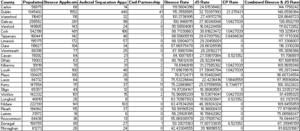COUNTY Carlow was the divorce capital of Ireland in 2015, according to the latest figures on marital breakdown from the Courts Service.
There were 68 divorce applications in the county last year, which was enough to give Carlow the highest rate in the Republic last year at around 120 applications per 100,000 people (based on Census 2016 figures).
Of less a surprise was the fact that Dublin was in second place with 1,552 applications for divorce last year, or one third of the national total (a rate of 115 applications per 100,000).
Next highest were Galway and Waterford, the only other two counties with a rate of divorce application higher than 100.
The rate of applications for divorce in counties like Carlow and Dublin is almost three times higher than in those counties with the lowest rates.
The figures showed that Monaghan and Donegal had the happiest marriages last year, with 42 and 50 applications for divorce per 100,000 people respectively.
In some of the smaller counties, the number of divorce applications could be counted on the fingers of both hands with just eight in Longford last year and six in Leitrim.
Overall, there were 4,290 divorce applications last year with 3,264 cases granted according to records compiled by the Courts Service from the circuit court.
A very small number of cases (it was 24 in 2014) are also dealt with by the High Court each year with the possibility also of cases reaching the Supreme Court.
Also recorded in the figures were the break-up of 75 civil partnerships — the effective precursor to same-sex marriage, which was introduced just five years ago.
The amount of such partnerships ending almost doubled last year from 38 in 2014 to 75, and it was Dublin which made up the bulk of the cases.
However, there were some odd spikes in certain counties like Tipperary and Kerry, which together recorded 18 of the 75 applications last year.
Many counties recorded none at all, including Roscommon, which famously was the only constituency in Ireland to vote no in last year’s marriage referendum.
Another 33 people applied for “nullity”, according to the figures, which is a declaration that the marriage was null and void and effectively had never happened.
However, no details of what these cases involved are provided but among the reasons why this would be allowed are lack of capacity, lack of consent, or that one or other party was “incapable of sexual intercourse”.
Despite the fact that divorce has been available now for more than two decades, many couples still choose to end their marriage by way of judicial separation.
Last year, 1,384 couples went down this road, which made up almost one quarter of all the applications for a formal break-up.
The counties where judicial separation was more popular are quite different from divorce with Kildare leading the way here.
Interestingly, the rate of application for judicial separation in Monaghan (39 per 100,000) was almost the same as that for divorce (42 per 100,000).
When applications for divorce and judicial separation are combined, Dublin has the highest rate of marriage breakdown ahead of Carlow and Galway.
Judicial separation can offer a simpler and less expensive way of allowing husbands and wives to part, particularly where they have no intention of remarrying.
Currently, couples must be separated for four years before qualifying for divorce although there is a proposal to reduce this to two years.
A private member’s bill has been put forward by Fine Gael TD Josepha Madigan, a former family law solicitor, and appears to have gained widespread support.
In a statement, the Courts Service said: “Like all our courts, family law courts are not just busy, they also reflect what is going on throughout society: where the country and people are at.
“This is as clear in family law courts as in other venues which might deal with commerce, business, or debt. All courts are presented and deal with every aspect of human endeavour, disagreements, and frailty: none more so than the family law courts.”
My calculations based on the provisional figures from Census 2016:

The full set of figures from the Courts Service are available here: